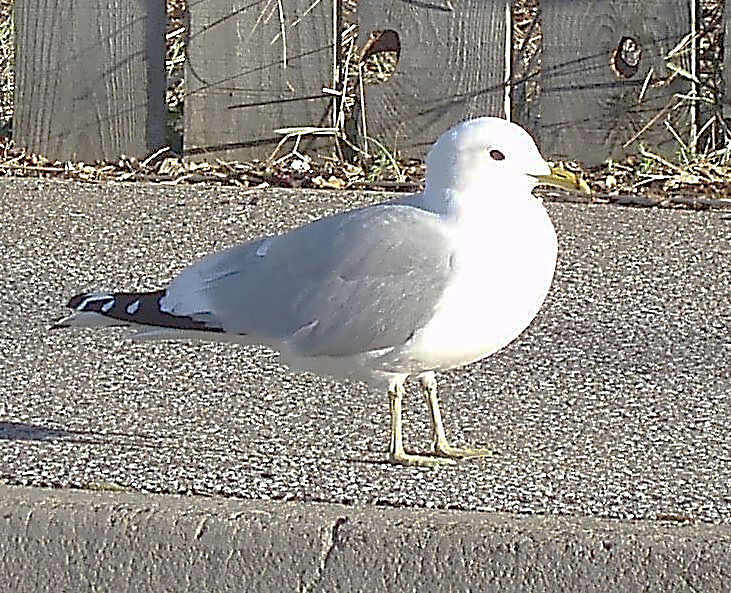Guidance - Gull identification and annual cycle guide
What Gull is that?
There are five species of gull that breed in Scotland, excluding two scarce species and black-legged kittiwakes which are exclusively marine. There are a number of other gull species that occur here as vagrants or on migration which are not covered here. All gull species are easy to identify though it is possible to confuse some unless you know the key features for identification. The five species are: great black-backed gull; lesser black-backed gull; herring gull; common (mew1) gull; and black-headed gull. See also the Wildlife Trusts website and the RSPB website for gull identification information.
Great black-backed gull (Larus marinus)

Great black-backed gulls are the largest of the five and is notable for its dark, almost black back, heavy yellow bill and flesh-pink legs. Like many other gulls, the main flight feathers (the primaries) have white spots, known as ‘mirrors’. As with all gulls, juvenile and immature plumage is very variable and size is the best identification feature. Great black-backed gulls are commonest along the west coast of Scotland and throughout the Northern Isles. They can be spotted throughout the year in Scotland. This is the most ‘marine’ gull of all five.
Lesser black-backed gull (Larus fuscus)

Lesser black-backed gulls share a lot of features with great black-backed gull but are smaller. The back is more of a dark slate-grey colour and while the head and bill are a similar colour, overall size and appearance is very distinctive. A key identification feature though is the leg colour which is bright yellow in the breeding season. As with all gulls, juvenile and immature plumage is very variable but size is the best identification feature to separate from great black-backed gull. Separating immature lesser black-backed gulls from immature herring gulls can be difficult even for experienced gull-watchers. Most lesser black-backed gulls migrate south in winter and do not reappear until March and April. Lesser black-backed gulls are widespread in Scotland but there are strong populations in SW Scotland and parts of the Central Belt.
Herring gull (Larus argentatus)

Herring gulls are the same size as lesser black-backed gulls but are easily separated by their much paler grey back, with black wing tips and white spots (‘mirrors’). The head and bill are similar to lesser black-backed gull, both having a yellow bill and a red spot towards the tip. A good identification feature is the flesh coloured, pink legs, which separate this species from lesser black-backed gull and common gull. As for other gulls, plumage is very variable in immature and sub-adult birds. The photo here is of an adult bird in breeding plumage. In winter, herring gulls gain a streaky/mottled head pattern. Many herring gulls in UK in winter originate from Scandinavia and they may have darker backs. Herring gulls are one of the commonest gulls breeding in towns and cities and occur in all parts of Scotland.
Common (mew) gull (Larus canus)

Common gulls are probably the least common gull of the main five breeding species in Scotland. It is much smaller than herring gulls and while superficially similar, has several distinctive features. The bill is much finer and tends to lack the red spot of herring gulls. The eye is dark, giving the head a softer, gentler appearance and of particular note, the legs are pale green-yellow. Like herring gulls the head takes on a streaked/mottled pattern in winter. Immatures have a mix of grey and brownish plumage. Common gulls often nest on buildings, though not as frequently as herring and lesser black-backed gulls. There are a number of very large inland colonies, especially on moorland managed for grouse shooting. Large numbers of common gulls migrate into Scotland from Scandinavia in winter. You can view this helpful video on distinguishing between herring gulls and commons gulls.
Black-headed gull (Chroicocephalus ridibundus)

The black-headed gull is the smallest regularly breeding gull in Scotland. In the breeding season its dark brown head (that often looks black) is unique to this species in Scotland. The bill is fine and bright red, as are the legs, making this one of the easiest gulls to identify in the field in the breeding season. Black-headed gulls lose their black heads in winter, retaining nothing other than a small dark mark behind the eye. The primary feathers also lack the ‘mirrors’ of the other gull species described here. All of these features make it an easy species to identify. Juvenile and immature birds have a mix of grey and brown feathers. Urban nesting by black-headed gulls is relatively uncommon but does occur. Black-headed gulls are common across Scotland in winter.
1 This is the name of this species in the United States.
- February-March: return of gulls to breeding colonies from wintering locations. Migrants start to return to Scandinavia.
- April: territory establishment and first eggs laid towards the end of April.
- May-June: main period of incubation (28 days) and chick hatching and growth.
- August-October: gulls disperse to winder locations. Large number of migrants from Scandinavia arrive (herring and common gulls especially).
- November-January: gulls remain in wintering locations.
Contact
If you already have a licence number, include it in the subject line of your email, or have it to hand when you call.




